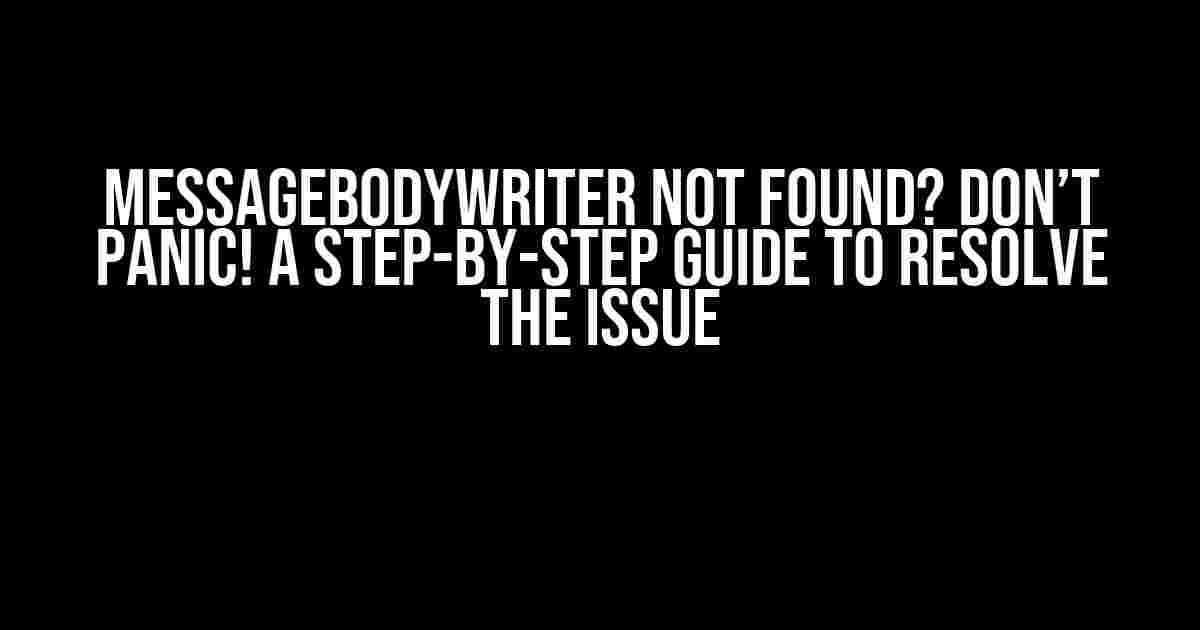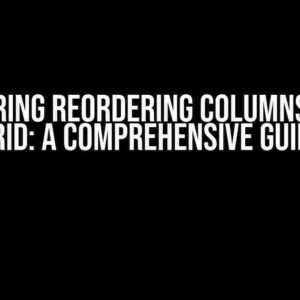Are you frustrated with the “MessageBodyWriter not found” error in your Java-based web application? You’re not alone! Many developers have faced this issue, and it’s more common than you think. In this article, we’ll delve into the root cause of the problem and provide a comprehensive guide to help you resolve it.
What is a MessageBodyWriter?
Before we dive into the solution, let’s take a step back and understand what a MessageBodyWriter is. In Java-based web services, particularly those using Jersey (the reference implementation of JAX-RS), a MessageBodyWriter is a crucial component responsible for serializing Java objects into a format that can be sent over HTTP.
Think of it as a translator that converts your Java objects into a format that can be understood by the client, such as JSON or XML.
The Error: MessageBodyWriter not found
Now, let’s talk about the error itself. When you encounter the “MessageBodyWriter not found” error, it means that the Jersey framework is unable to find a suitable MessageBodyWriter to serialize your Java object into a format that can be sent over HTTP.
This error can occur due to various reasons, including:
- Missing or incorrect dependencies in your project
- Incorrect configuration of the Jersey framework
- Incompatible versions of Jersey and other dependencies
- Incorrectly implemented Java objects
Step 1: Verify Your Dependencies
The first step in resolving the “MessageBodyWriter not found” error is to verify that you have the necessary dependencies in your project. You’ll need to ensure that you have the following dependencies:
- Jersey (com.sun.jersey:jersey-bundle)
- Java API for RESTful Web Services (JAX-RS) (javax.ws.rs:jaxrs-api)
- Java Architecture for XML Binding (JAXB) (javax.xml.bind:jaxb-api)
- _JSON provider (e.g., org.glassfish.jersey.media:jersey-media-json-binding)_
If you’re using Maven, add the following dependencies to your pom.xml:
<dependencies>
<dependency>
<groupId>com.sun.jersey</groupId>
<artifactId>jersey-bundle</artifactId>
<version>1.19.4</version>
</dependency>
<dependency>
<groupId>javax.ws.rs</groupId>
<artifactId>jaxrs-api</artifactId>
<version>2.1</version>
</dependency>
<dependency>
<groupId>javax.xml.bind</groupId>
<artifactId>jaxb-api</artifactId>
<version>2.3.1</version>
</dependency>
<dependency>
<groupId>org.glassfish.jersey.media</groupId>
<artifactId>jersey-media-json-binding</artifactId>
<version>2.31</version>
</dependency>
</dependencies>
Step 2: Configure Jersey Framework
Once you’ve verified your dependencies, let’s move on to configuring the Jersey framework. You’ll need to create a Jersey application configuration class that defines the resources and providers:
package com.example.config;
import org.glassfish.jersey.server.ResourceConfig;
import org.glassfish.jersey.server.ServerProperties;
public class JerseyConfig extends ResourceConfig {
public JerseyConfig() {
packages("com.example.resources");
property(ServerProperties.MEDIATYPE_MAPPING_FEATURE, true);
}
}
In this example, we’re telling Jersey to scan for resources in the com.example.resources package.
Step 3: Implement Java Objects
Now, let’s talk about implementing your Java objects. When creating a Java object that will be serialized by a MessageBodyWriter, you’ll need to ensure that it’s correctly annotated:
package com.example.resources;
import javax.xml.bind.annotation.XmlRootElement;
import javax.xml.bind.annotation.XmlAccessorType;
import javax.xml.bind.annotation.XmlAccessType;
@XmlRootElement
@XmlAccessorType(XmlAccessType.FIELD)
public class MyObject {
private String name;
private int age;
// getters and setters
}
In this example, we’re using JAXB annotations to define the XML structure of our Java object.
Step 4: Register MessageBodyWriters and Providers
The final step is to register the necessary MessageBodyWriters and providers in your Jersey application configuration class:
package com.example.config;
import org.glassfish.jersey.server.ResourceConfig;
import org.glassfish.jersey.server.ServerProperties;
import org.glassfish.jersey.media.json.JsonFeature;
import org.glassfish.jersey.jackson.JacksonFeature;
public class JerseyConfig extends ResourceConfig {
public JerseyConfig() {
packages("com.example.resources");
property(ServerProperties.MEDIATYPE_MAPPING_FEATURE, true);
register(JsonFeature.class);
register(JacksonFeature.class);
}
}
In this example, we’re registering the JsonFeature and JacksonFeature providers, which will enable JSON serialization and deserialization.
Troubleshooting Tips
If you’ve followed the steps above and are still encountering issues, here are some troubleshooting tips:
- Verify that you’ve correctly implemented your Java objects and that they’re correctly annotated.
- Check that you’ve registered the necessary MessageBodyWriters and providers in your Jersey application configuration class.
- Ensure that you’ve correctly configured the Jersey framework and that it’s correctly scanning for resources.
- Check the versions of your dependencies and ensure that they’re compatible.
Conclusion
Resolving the “MessageBodyWriter not found” error requires a thorough understanding of the Jersey framework and its dependencies. By following the steps outlined in this article, you should be able to identify and resolve the root cause of the issue. Remember to verify your dependencies, configure the Jersey framework, implement your Java objects correctly, and register the necessary MessageBodyWriters and providers.
If you’re still encountering issues, don’t hesitate to seek help from online communities or forums. With patience and persistence, you’ll be able to resolve the “MessageBodyWriter not found” error and get your Java-based web application up and running.
| Dependency | Version |
|---|---|
| Jersey | 1.19.4 |
| JAX-RS | 2.1 |
| JAXB | 2.3.1 |
| JSON provider (e.g., jersey-media-json-binding) | 2.31 |
Remember to update the versions according to your project requirements.
Frequently Asked Question
Stuck with the frustrating “MessageBodyWriter not found” error? Don’t worry, we’ve got you covered! Here are some frequently asked questions and answers to help you troubleshoot and resolve this issue.
What causes the “MessageBodyWriter not found” error?
The “MessageBodyWriter not found” error occurs when the Jersey (JAX-RS) framework is unable to find a suitable MessageBodyWriter to convert a Java object into a response entity. This can happen due to a missing or incorrect implementation of the MessageBodyWriter interface, or when the writer is not registered in the Jersey configuration.
How do I register a custom MessageBodyWriter?
To register a custom MessageBodyWriter, you need to implement the MessageBodyWriter interface and annotate your class with @Provider. Then, register your writer in the Jersey configuration using the ResourceConfig class or through the web.xml file.
What is the difference between a MessageBodyWriter and a MessageBodyReader?
A MessageBodyWriter is responsible for converting a Java object into a response entity, while a MessageBodyReader is responsible for converting a request entity into a Java object. Both are essential components of the Jersey framework, and you may need to implement or register both depending on your specific requirements.
Can I use multiple MessageBodyWriters for the same media type?
Yes, you can use multiple MessageBodyWriters for the same media type by implementing a custom WriterResolver or using a third-party library like MOXy. This allows you to handle different scenarios or formats for the same media type.
How do I debug a “MessageBodyWriter not found” error?
To debug a “MessageBodyWriter not found” error, enable Jersey’s debug logging, check your writer’s implementation and registration, and verify that the writer is capable of handling the specific media type and Java object. You can also use tools like Wireshark or Fiddler to inspect the HTTP traffic and identify the issue.






